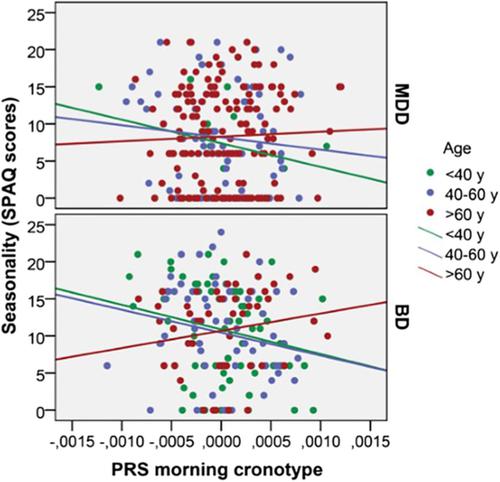当前位置:
X-MOL 学术
›
Genes Brain Behav.
›
论文详情
Our official English website, www.x-mol.net, welcomes your
feedback! (Note: you will need to create a separate account there.)
Clock gene polygenic risk score and seasonality in major depressive disorder and bipolar disorder.
Genes, Brain and Behavior ( IF 2.4 ) Pub Date : 2020-06-22 , DOI: 10.1111/gbb.12683 Alex Ferrer 1, 2 , Javier Costas 3 , Mònica Gratacos 4 , Èrika Martínez-Amorós 1, 5 , Javier Labad 1, 5, 6 , Carles Soriano-Mas 5, 7, 8 , Diego Palao 1, 5, 6 , Jose Manuel Menchón 2, 5, 7 , Jose Manuel Crespo 2, 5, 7 , Mikel Urretavizcaya 2, 5, 7 , Virginia Soria 2, 5, 7
Genes, Brain and Behavior ( IF 2.4 ) Pub Date : 2020-06-22 , DOI: 10.1111/gbb.12683 Alex Ferrer 1, 2 , Javier Costas 3 , Mònica Gratacos 4 , Èrika Martínez-Amorós 1, 5 , Javier Labad 1, 5, 6 , Carles Soriano-Mas 5, 7, 8 , Diego Palao 1, 5, 6 , Jose Manuel Menchón 2, 5, 7 , Jose Manuel Crespo 2, 5, 7 , Mikel Urretavizcaya 2, 5, 7 , Virginia Soria 2, 5, 7
Affiliation

|
Seasonal changes in mood and diurnal preference are two well‐characterized chronobiological phenotypes in major depressive disorder (MDD) and bipolar disorder (BD). The biological mechanisms regulating physiological changes related to seasonality and chronotype involve several genes known as “clock” or circadian genes. Our goal was to study the relationship between the polygenic risk score (PRS) obtained from a set of clock genes and chronobiological traits in patients with mood disorders. The sample included 445 patients with mood disorders (256 MDD; 189 BD). Seasonality was assessed using the Seasonal Pattern Assessment Questionnaire (SPAQ), and chronotype was assessed using the Horne and Östberg Morningness–Eveningness Questionnaire. We selected 248 single nucleotide polymorphisms located within 19 genes. PRS for both MDD and BD was calculated using the Psychiatric Genetics Consortium latest datasets as discovery samples. Another PRS was calculated using results from a genome‐wide association study focusing on chronotype. SPAQ results were significantly associated with MDD‐PRS (p = 0.037) and chronotype‐PRS (p = 0.019), which also showed a significant interaction with age (p = 0.039). No significant association was observed between the measured PRS and chronotype. Our results reflect that small effect variants associated with MDD and chronotype within clock genes are associated with seasonality traits in patients with mood disorders, further explaining the mechanism through which the circadian system might influence mood disorder clinical presentation. Future studies measuring PRS from specific gene sets and focusing on biological endophenotypes will help to elucidate the pathways from genetic variations to clinical outcome.
中文翻译:

重度抑郁症和双相情感障碍的时钟基因多基因风险评分和季节性。
情绪和昼夜偏好的季节性变化是重度抑郁症 (MDD) 和双相情感障碍 (BD) 中两种典型的时间生物学表型。调节与季节性和生物钟相关的生理变化的生物学机制涉及几个称为“时钟”或昼夜节律基因的基因。我们的目标是研究从一组时钟基因中获得的多基因风险评分 (PRS) 与情绪障碍患者的时间生物学特征之间的关系。样本包括 445 名情绪障碍患者(256 MDD;189 BD)。使用季节性模式评估问卷 (SPAQ) 评估季节性,使用 Horne 和 Östberg Morningness-Eveningness 问卷评估睡眠类型。我们选择了位于 19 个基因内的 248 个单核苷酸多态性。MDD 和 BD 的 PRS 是使用精神病遗传学联盟的最新数据集作为发现样本计算的。另一个 PRS 是使用专注于时间型的全基因组关联研究的结果计算的。SPAQ 结果与 MDD-PRS 显着相关(p = 0.037) 和 chronotype-PRS ( p = 0.019),这也显示出与年龄的显着相互作用 ( p = 0.039)。未观察到测量的 PRS 与计时型之间存在显着关联。我们的结果反映了与 MDD 相关的小效应变异和时钟基因中的时间型与情绪障碍患者的季节性特征相关,进一步解释了昼夜节律系统可能影响情绪障碍临床表现的机制。未来从特定基因组测量 PRS 并关注生物内表型的研究将有助于阐明从遗传变异到临床结果的途径。
更新日期:2020-06-22
中文翻译:

重度抑郁症和双相情感障碍的时钟基因多基因风险评分和季节性。
情绪和昼夜偏好的季节性变化是重度抑郁症 (MDD) 和双相情感障碍 (BD) 中两种典型的时间生物学表型。调节与季节性和生物钟相关的生理变化的生物学机制涉及几个称为“时钟”或昼夜节律基因的基因。我们的目标是研究从一组时钟基因中获得的多基因风险评分 (PRS) 与情绪障碍患者的时间生物学特征之间的关系。样本包括 445 名情绪障碍患者(256 MDD;189 BD)。使用季节性模式评估问卷 (SPAQ) 评估季节性,使用 Horne 和 Östberg Morningness-Eveningness 问卷评估睡眠类型。我们选择了位于 19 个基因内的 248 个单核苷酸多态性。MDD 和 BD 的 PRS 是使用精神病遗传学联盟的最新数据集作为发现样本计算的。另一个 PRS 是使用专注于时间型的全基因组关联研究的结果计算的。SPAQ 结果与 MDD-PRS 显着相关(p = 0.037) 和 chronotype-PRS ( p = 0.019),这也显示出与年龄的显着相互作用 ( p = 0.039)。未观察到测量的 PRS 与计时型之间存在显着关联。我们的结果反映了与 MDD 相关的小效应变异和时钟基因中的时间型与情绪障碍患者的季节性特征相关,进一步解释了昼夜节律系统可能影响情绪障碍临床表现的机制。未来从特定基因组测量 PRS 并关注生物内表型的研究将有助于阐明从遗传变异到临床结果的途径。











































 京公网安备 11010802027423号
京公网安备 11010802027423号